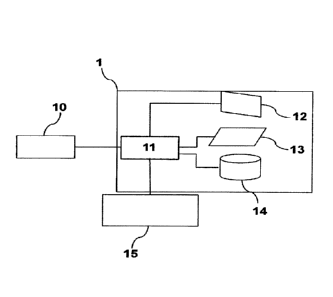Some of the information on this Web page has been provided by external sources. The Government of Canada is not responsible for the accuracy, reliability or currency of the information supplied by external sources. Users wishing to rely upon this information should consult directly with the source of the information. Content provided by external sources is not subject to official languages, privacy and accessibility requirements.
Any discrepancies in the text and image of the Claims and Abstract are due to differing posting times. Text of the Claims and Abstract are posted:
| (12) Patent: | (11) CA 2971506 |
|---|---|
| (54) English Title: | TIMER DEVICE AND METHOD FOR OPERATING SAID TIMER DEVICE |
| (54) French Title: | DISPOSITIF DE TEMPORISATEUR ET PROCEDE DE FONCTIONNEMENT DUDIT DISPOSITIF DE TEMPORISATEUR |
| Status: | Granted |
| (51) International Patent Classification (IPC): |
|
|---|---|
| (72) Inventors : |
|
| (73) Owners : |
|
| (71) Applicants : |
|
| (74) Agent: | PRIMA IP |
| (74) Associate agent: | |
| (45) Issued: | 2023-01-31 |
| (86) PCT Filing Date: | 2014-12-19 |
| (87) Open to Public Inspection: | 2016-06-23 |
| Examination requested: | 2019-12-03 |
| Availability of licence: | N/A |
| (25) Language of filing: | English |
| Patent Cooperation Treaty (PCT): | Yes |
|---|---|
| (86) PCT Filing Number: | PCT/EP2014/078692 |
| (87) International Publication Number: | WO2016/096034 |
| (85) National Entry: | 2017-06-19 |
| (30) Application Priority Data: | None |
|---|
The timer device(1) comprises a first timer (12) in communication with control means(11), said control means (11) being in communication with an external component (15) and said first timer (12) sending an order to the control means (11) after a first preset time period is counted by the first timer (12), and it is characterized in that the timer device also comprises a second timer (13) in communication with said control means (11), said second timer (13) counting a second preset time period that is a portion of said first preset time period. It permits an accurate operation, even with changes of temperature and voltage and with a reduced cost.
Le dispositif de temporisateur (1) comprend un premier temporisateur (12) en communication avec un moyen de commande (11), ledit moyen de commande (11) étant en communication avec un composant externe (15) et ledit premier temporisateur (12) envoyant un ordre au moyen de commande (11) après qu'une première période de temps préétablie est comptée par le premier temporisateur (12), et il est caractérisé en ce que le dispositif de temporisateur comprend également un second temporisateur (13) en communication avec ledit moyen de commande (11), ledit second temporisateur (13) comptant une seconde période de temps préétablie qui est une partie de ladite première période de temps préétablie. Il permet un fonctionnement précis, même avec des changements de température et de tension, et avec un coût réduit.
Note: Claims are shown in the official language in which they were submitted.
Note: Descriptions are shown in the official language in which they were submitted.

For a clearer understanding of the status of the application/patent presented on this page, the site Disclaimer , as well as the definitions for Patent , Administrative Status , Maintenance Fee and Payment History should be consulted.
| Title | Date |
|---|---|
| Forecasted Issue Date | 2023-01-31 |
| (86) PCT Filing Date | 2014-12-19 |
| (87) PCT Publication Date | 2016-06-23 |
| (85) National Entry | 2017-06-19 |
| Examination Requested | 2019-12-03 |
| (45) Issued | 2023-01-31 |
There is no abandonment history.
Last Payment of $210.51 was received on 2023-11-30
Upcoming maintenance fee amounts
| Description | Date | Amount |
|---|---|---|
| Next Payment if standard fee | 2024-12-19 | $347.00 |
| Next Payment if small entity fee | 2024-12-19 | $125.00 |
Note : If the full payment has not been received on or before the date indicated, a further fee may be required which may be one of the following
Patent fees are adjusted on the 1st of January every year. The amounts above are the current amounts if received by December 31 of the current year.
Please refer to the CIPO
Patent Fees
web page to see all current fee amounts.
| Fee Type | Anniversary Year | Due Date | Amount Paid | Paid Date |
|---|---|---|---|---|
| Application Fee | $400.00 | 2017-06-19 | ||
| Maintenance Fee - Application - New Act | 2 | 2016-12-19 | $100.00 | 2017-06-19 |
| Registration of a document - section 124 | $100.00 | 2017-08-09 | ||
| Maintenance Fee - Application - New Act | 3 | 2017-12-19 | $100.00 | 2017-12-05 |
| Maintenance Fee - Application - New Act | 4 | 2018-12-19 | $100.00 | 2018-11-28 |
| Request for Examination | 2019-12-19 | $800.00 | 2019-12-03 | |
| Maintenance Fee - Application - New Act | 5 | 2019-12-19 | $200.00 | 2019-12-05 |
| Maintenance Fee - Application - New Act | 6 | 2020-12-21 | $200.00 | 2020-12-15 |
| Maintenance Fee - Application - New Act | 7 | 2021-12-20 | $204.00 | 2021-12-10 |
| Final Fee | 2022-11-07 | $306.00 | 2022-10-04 | |
| Maintenance Fee - Application - New Act | 8 | 2022-12-19 | $203.59 | 2022-11-29 |
| Maintenance Fee - Patent - New Act | 9 | 2023-12-19 | $210.51 | 2023-11-30 |
Note: Records showing the ownership history in alphabetical order.
| Current Owners on Record |
|---|
| ZOBELE HOLDING SPA |
| Past Owners on Record |
|---|
| None |